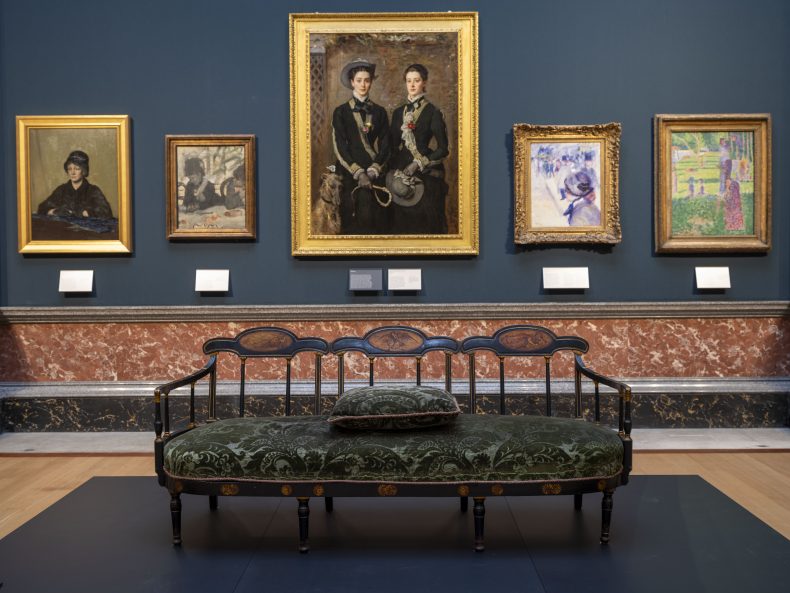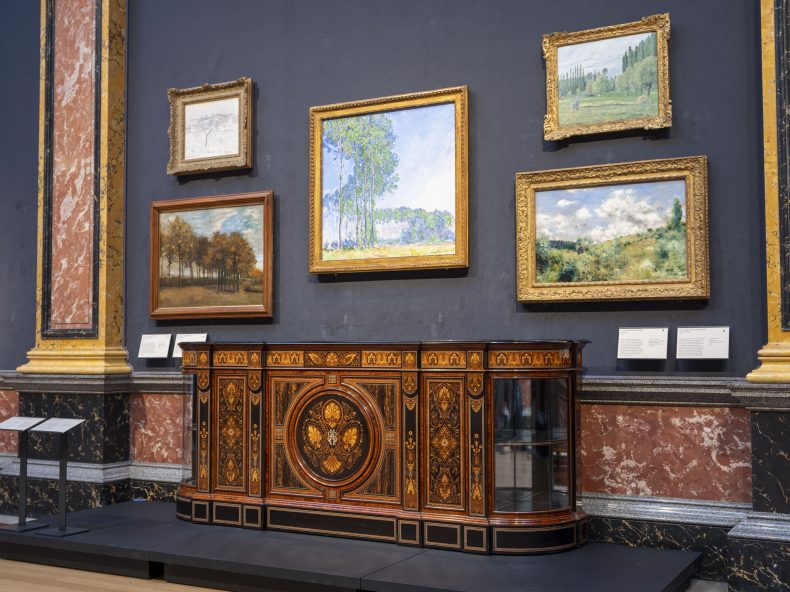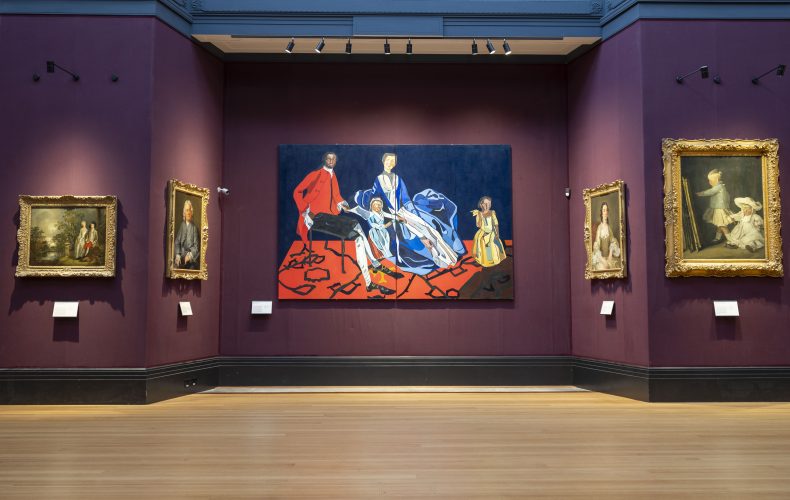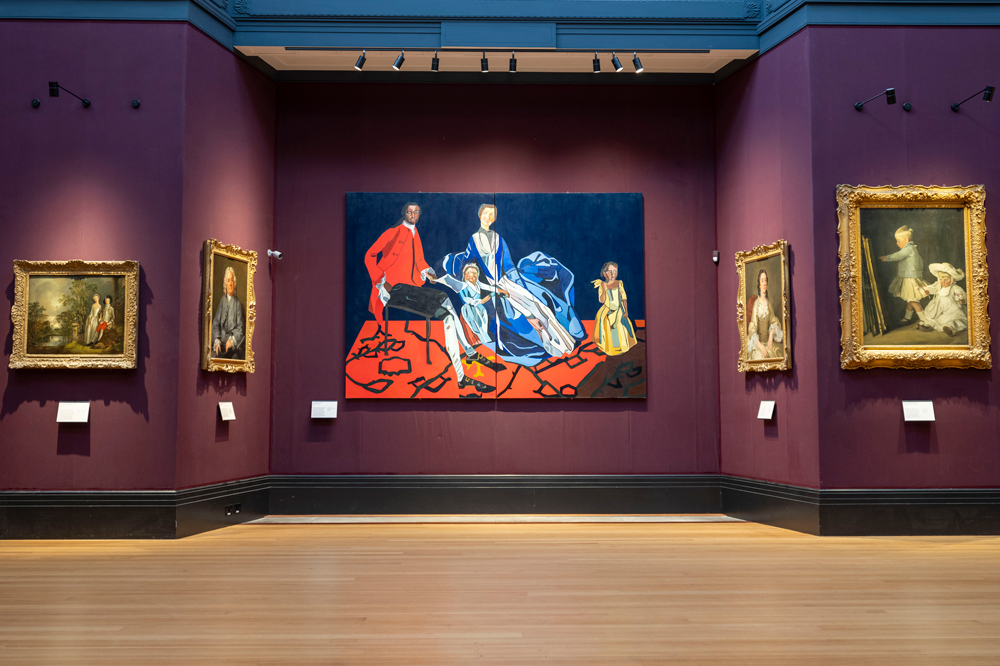When the Fitzwilliam’s rehang of five of its main rooms was unveiled in March, the Observer ran the story under the headline ‘“Inclusivity shouldn’t be controversial”: will a radical art rehang give Cambridge an unwanted “woke” row?’ Within a few hours, under the headline ‘Fitzwilliam Museum’s inclusive rehang “not woke”’, the Telegraph website seemed to confirm that, yes, an unwanted ‘woke’ row was exactly what Cambridge would be getting.
While most of the museum’s picture galleries stick to traditional geographical-chronological categories – ‘Spanish and Flemish art, 16th–18th centuries’ – Galleries I to V, which used to contain mainly French and British painting from the 16th to the 20th centuries, have been remixed into a series of themes: ‘Identity’, ‘Migration and Movement’, ‘Nature’, ‘Men Looking at Women’ and ‘Interiors’. Scattered among old favourites – Pompeo Girolamo Batoni’s grand representation of the 7th Earl of Northampton, with his gorgeous fur-lined red cloak and eager whippet; Stubbs’s pleasingly mundane fantasy portrait Isabella Saltonstall as Una in Spenser’s ‘Faerie Queene’; Renoir’s beautiful, ungraspable The Gust of Wind – are more paintings by women and artists who were or are other than white, and more paintings with overtly queer themes (or, in some cases, covertly queer themes pointed up in the accompanying labels).
Installation view of The Twins, Kate and Grace Hoare (1876) by John Everett Millais in the rehung ‘Men Looking at Women’ gallery at the Fitzwilliam Museum. Photo: © Fitzwilliam Museum, University of Cambridge

Is this woke? In one sense, of course: at any rate, it’s the sort of thing that people who complain about ‘wokeness’ have in mind. But ‘wokeness’ is an unhelpfully baggy category, which often seems to involve objecting to any attention paid to the political and social contexts in which paintings and their reputations are made. The day after the rehang opened to the public, someone called @GrumpyArt on what I still think of as Twitter gained attention with a complaint about the new label attached to a painting in the ‘Nature’ gallery: ‘Fitzwilliam Museum telling off Samuel Palmer because he wasn’t painting poverty! More text about what he didn’t paint than what he did. In the notorious “racist landscapes” room, which I visited today.’ The painting is Palmer’s View of Lee, North Devon (1834–35): the label says that ‘Palmer’s landscapes show no sign of the industrial age that was making its mark on the environment. Nor do they register the poverty of agricultural workers, which was worsened by the Poor Law, introduced the year this work was made.’ This isn’t great (quite a lot of the labels aren’t): the painting does, as it happens, represent the rural poor, in the figures of a shepherd driving his flock and a woman carrying a bundle of twigs on her back. It seems unfair, too, to pick on Palmer while neighbouring landscapes by Gainsborough, Constable and Hockney pass without comment. Still, there’s nothing especially radical in the label’s critique of landscape painting – it certainly won’t surprise anyone familiar with John Berger’s Ways of Seeing (1972).
The ‘Nature’ gallery at the Fitzwilliam Museum. Photo: © Fitzwilliam Museum, University of Cambridge

A more important question is: does the new hang work? Well, yes and no. The ‘Nature’ gallery is coherent and contains a lot of rather lovely art, from Stubbs and Wright of Derby through Monet, Van Gogh and Cézanne up to Stanley Spencer and Paul Nash, who is represented by the visionary November Moon (1942). Jake Grewal’s Laid to Rest (2021–22), a dream of a misty, primordial Eden, doesn’t seem out of place, despite a label too keen to tell you what to think (‘creates new possibilities for queer desire and kinship within landscapes’). ‘Identities’ is less convincing as a category: why not just ‘portraits’, which is what the room contains? Still, there are fine things in here: Van Dyck’s portrait of the 4th Countess of Southampton, foot resting, disconcertingly, on a skull; Henry Lamb’s anxious, abstracted Lytton Strachey from 1913–14 paired with a more languorous idea of him by Vanessa Bell a few years earlier; Winifred Nicholson’s Father and Son, her husband Ben nuzzling their infant son Jake, which the museum acquired in 2022. There are other welcome arrivals, including Kerry James Marshall’s painting of Henry Louis Gates Jr (2020), a neat hybrid of the classical and the modern, and Joy Labinjo’s An 18th-century Family (2022) – an imaginary group portrait of Olaudah Equiano, the freed slave whose autobiography was hugely influential on the abolitionist movement; his wife Susannah (from Soham, just up the road from Cambridge); and their daughters, seated in a dark space, with ambiguous black lines, shackles or plant tendrils, curling around the floor.
Installation view of An 18th-century Family (2022) by Joy Labinjo. Photo: © Fitzwilliam Museum, University of Cambridge; © the artist

‘Migration and Movement’ is a little messy. The odd painting that does deal with migration, like the Fitzwilliam’s 1860 version of Ford Madox Brown’s The Last of England (first painted in 1855), sits with work by artists who were either émigrés (Frank Auerbach, Nat Leeb) or, more tenuously, the children of émigrés (David Bomberg, Mark Gertler). There’s a conversation to be had between, say, Gertler’s still life Violin and Bust (1934) and the Guyanese artist Aubrey Williams’s quasi-abstract Now and Coming Time II (Olmec-Maya and Now), but it doesn’t have a lot to do with migration. Then again, a chronological hang wouldn’t have brought them together.
The Last of England (1860), Ford Madox Brown. Photo: © Fitzwilliam Museum, University of Cambridge

The category ‘Men Looking at Women’ feels like an afterthought – most of these paintings could fit somewhere else and the room doesn’t comment usefully on what the title implies. It’s a shame that the room’s theme cannot accommodate Ethel Walker’s intriguing Silence of the Ravine (1916) – reputedly the first nude by a lesbian artist – in which the model seems to be admiring her own body through half-closed eyes; instead, that’s placed next door, in ‘Interiors’. That room also contains one of the best things here, a wall of women reading, by Fragonard, Angelica Kauffman, Édouard Vuillard, Pierre Bonnard and Gwen John, which collectively feel like a call to contemplation, a reproach to the impulse to buzz round the museum, glancing at the work. Whatever else the Fitzwilliam may be, it remains a place to linger and think – and perhaps to think some new thoughts.
The Convalescent (1924), Gwen John. Photo: © Fitzwilliam Museum, University of Cambridge




